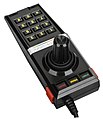History of video games/Platforms/Atari 5200
-
The Atari 5200 with controller attached.
History
[edit | edit source]
Launch
[edit | edit source]
The Atari 5200 was released in the United States of America in the summer of 1982 at a cost of $270.[1]
The console struggled in the market, as regular consumers did not like that the 5200 could not play their old 2600 games they owned.[2] While backwards compatibility as a concept was novel to game systems at the time, a lack of support for old games harmed sales. Complicating matters, poor coordination by Atari lead to 2600 games flooding the market after the Atari 5200 release,[3] which probably harmed the success of the system by not only reducing the incentive to upgrade, but also by releasing major games that would be incompatible with the 5200.
Legacy
[edit | edit source]Production of the Atari 5200 ceased by May 21st, 1984 as Atari announced the successor system - the Atari 7800.[4][5] Over one million Atari 5200 consoles were sold.[6]
Technology
[edit | edit source]The Atari 5200 was based on the Atari 400 computer[7] and used an 8-bit 6502C CPU clocked at 1.79 megahertz.[1] The Atari 5200 has 16 kilobytes of RAM.[1] The Atari 5200 had 2 kilobytes of storage for its BIOS.[4]
By being based off of Atari home computers, game ports from these computers to the 5200 were supposed to be easier.[8] The trade off was a radically different architecture from the prior Atari 2600, potentially resulting in less portability between the two.
Notable games
[edit | edit source]Wikipedia has a list of Atari 5200 games.
Special Editions
[edit | edit source]A special version of the 5200 was made for use in hotels.[8]
Gallery
[edit | edit source]4 Port Console
[edit | edit source]Controllers
[edit | edit source]Other items
[edit | edit source]Internals
[edit | edit source]References
[edit | edit source]- ↑ a b c "OLD-COMPUTERS.COM : The Museum". www.old-computers.com. Retrieved 27 October 2020.
- ↑ Patterson, Patrick Scott (1 November 2017). "Back to the Future: A Look at the History of Backwards Compatibility". Scholarly Gamers. Retrieved 11 December 2020.
- ↑ Trautman, Ted. "Excavating the Video-Game Industry’s Past" (in en-us). The New Yorker. https://www.newyorker.com/business/currency/excavating-the-video-game-industrys-past.
- ↑ a b "History of Consoles: Atari 5200 (1982) Gamester 81". Retrieved 27 October 2020.
- ↑ Sanger, David E. (22 May 1984). "ATARI VIDEO GAME UNIT INTRODUCED (Published 1984)". The New York Times. Retrieved 2 December 2020.
- ↑ "Atari 5200 SuperSystem (1982 - 1984)". Museum of Obsolete Media. 7 March 2014. Retrieved 28 October 2020.
- ↑ "Atari 5200 console - CHM Revolution". www.computerhistory.org. Retrieved 27 October 2020.
- ↑ a b "ATARI 5200 SUPERSYSTEM FREQUENTLY ASKED QUESTIONS". Retrieved 14 January 2021.






















